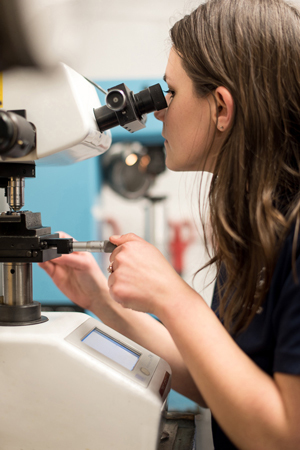Why is Surface Finish Important? Understanding the Critical Raw Material Characteristic of Roughness
Surface Finish is one of the most important factors when it comes to ordering material or following a specification. Due to the wide variety of effects different surface finishes can have, it should never be loosely defined or left up to interpretation. The easiest way to achieve this is to identify surface finish via the standard industry designation or the proprietary designation. If at this point you are still thinking Surface Finish doesn’t matter for my product, I would ask that you consider the following aspects that a finish can have on your material:
- It provides a certain visual appeal
- It can have a big effect on corrosion resistance
- It has different effects on certain manufacturing operations
- Money. Different finishes require different economic considerations
It is important that once a particular Surface Finish is decided and then determined to work successfully for a manufacturer and their application, that all the metal they source has that exact finish every single time. This goes back to ensuring repeatability, consistency, and quality of the material you use to produce your products. Manufacturers and steel buyers should always work with your rolling partner to make sure that the metal you buy is produced the same way every time and superior quality and precision is maintained. This is crucial because finish can be affected by all of the following:
- Cleanliness
- Finish on the actual rolls
- Supplier and supplier’s supplier
- Thickness
- Production route

What are the different types of metal finishes?
Let’s take a dive in to the different types of finishes now and what each entail. Ulbrich has vast capabilities when it comes to Surface Finish and will always work with you to determine which is most appropriate. Whether you are looking for a typical mill finish or something shiny with a mirror finish appearance, we will work with you to get the proper surface finish. One fabricator may be looking for a finish that helps with corrosion while another may need something specific to help their machining. Our process is in place to help with both. One of the most common finishes is the #2 Finish. This is material that has been cold rolled and annealed, and then put through a light pass on highly polished rolls. It correlates to what the major melt mills would call a 2B finish or a bright annealed finish. Another very popular finish is the rolled dull (RD) finish. Melt mills typically call it a 2D finish for sheet and sometimes a #1 Finish for strip. This finish is just cold rolled and annealed but without the bright finish, and typically has a rougher surface finish.
Continue reading The Ultimate Guide to Stainless Steel Surface Finishes for an overview of all the types of finishes available on our stainless steel sheet products.
What is surface roughness?
Surface roughness, a measure of the texture of a manufactured surface, is usually a key factor that is specified by manufacturers when it comes to finish. It is based on a statistical representation of the high frequency surface deviations (microscopic peaks and valleys) from the local mean surface height. Think of roughness as tiny channels between a forming machine and the raw material. Having the proper roughness means having the proper oil contact. This can make the difference between being able to make a part and disaster. On the aesthetic side, roughness provides reflectivity, either shiny or dull. Within the surface roughness parameters, there are many terms worth looking at.
How is surface finish measured?

A Blizzard of “R”
A brief web search of surface roughness parameters will yield hundreds of abbreviations and formulas. Ra, Rq, Rsk, Rku Rp lead way to the obscure descriptions of arithmetic average, root mean squared, skewness, kurtosis and maximum peak height. And these only represent a few of the many values!
Attempting to follow the mathematical formula to gain a better understanding is even more cumbersome. Each value has importance, so where do we even start? The real question we need to ask is: what is important to us? Most application requirements can be discussed with just a few common values. What we really need to define and communicate is how rough the surface is on average, and how to define unwanted surface conditions.
Surface Roughness: Ra
When we spoke about the dull refrigerator, we were speaking about Ra.

Metals are not completely flat when we look at the surface under a microscope. There are peaks and valleys much like a mountain range over the entire surface. The Ra value expresses the average of the peaks and valleys of a surface. The image to the right shows how this value is determined. Values are typically expressed in microinches or micrometers. Micro means one millionth, so the values we are speaking in are very small. For example, Ulbrich defines our typical #2 finish as 12 microinches maximum. That means 12 millionths of an inch!
Average roughness is important because it best defines the surface. Qualitative statements such as “I want smooth material” or “I want rough material” are the metallurgical equivalent of going to a restaurant and saying “I want something yummy.” We must be specific in how we talk about surface finish and surface texture because the surface has specific needs. Saying “I need a surface between 15 and 30 microinches Ra because I want this fridge to hide fingerprints” is akin to “I need a meal without peanuts because I have allergies.” Well, it’s a close analogy although fridges are not allergic to fingerprints.
Condition Measuring: Ry
Condition is a precursor for the term defect. Defect is the conclusion that a condition is not acceptable. How do we determine if a surface condition is a defect? With surface roughness of course! This time we will employ the use of the roughness term Ry. This is defined as the maximum height of the surface profile. It is the difference between the highest peak and the lowest valley of a sample. This value is beneficial to us because it will show us conditions in the surface that are far from the average. The most common conditions that are not close to the average roughness are scuffs and scratches. The use of profilometry allows Ulbrich and customers to speak in similar terms. It is very difficult to determine acceptance criteria for scuffs and scratches using subjective means. Imagine attempting to talk about a scuff by how it looks or how it feels? Industry sometimes defines a scratch as a depressed condition greater than Ry 100 microinches. A scuff is therefore often defined as any similar condition below Ry 100 microinches.
The Hybrid: Rz
Getting right to the definition, Rz is the distance between the peaks and valleys of a sample. This sounds quite like Ry! However, Rz is the sum of the average of the 5 tallest peaks and the 5 lowest valleys, sometimes referred to as the roughness average. Curious, this part sounds a lot like Ra. This hybrid aspect raises some concern when using Rz in place of Ry or Ra. Rz is less sensitive to surface conditions when compared to Ry. This means that if there is a big scratch and a few smaller scuffs, the severity of the big scratch is diminished when averaged with the scuffs. Rz is more sensitive to overall roughness when compared to Ra. Rz is only averaging the top 5 highest and top 5 lowest sections. Ra is averaging the entire measured distance.
The importance of working with a rolling partner with advanced surface control capabilities
A precision rolling partner will work with you to identify your appropriate surface roughness, which will in turn help determine the appropriate finish for your application. At Ulbrich, our capabilities range from bright to dull, which can include a roughness range from 10 nanometers to 60 microinches. If your requirements call for a custom surface finish, a special texture can be mechanically applied (rolled). We are able to achieve these specific finishes because of our surface control capabilities and manufacturing process.

Surface control capabilities stem from the understanding the work hardening rate of a given alloy and heat lot is essential to meeting the customer’s specified mechanical properties. At Ulbrich, our team of metallurgists and steel processing experts understand that proper strip temperature control will result in more uniform mechanical properties and grain structure throughout the entire length of a coil. If grains are grown too large, the bulk material may exhibit erratic mechanical properties or an undesirable surface finish. We are able to produce metal finishes consistently even when the specified requirements include difficult to achieve surface conditions. This is the result of our years of expertise, advanced surface control equipment and technology, and refined production process. In addition to proprietary technologies that ensure finish, Ulbrich has industry-leading atmosphere control capabilities which prevent undesirable surface characteristics such as the formation of excess oxidation; this allows the strip to retain a consistent rolled finish. Our customers benefit from working with a team of experienced metallurgists who work with them to achieve tailored properties based on their individual requirements.
Precision re-rollers offer far more control over surface finish than you would be able to source from a melt mill. Ulbrich works with many of our customers to offer many types of special, customized, application and process specific finishes that would never be accessible from a melt mill. If you still have questions, please contact a specialist below and we would be happy to help you reach your desired final product!



